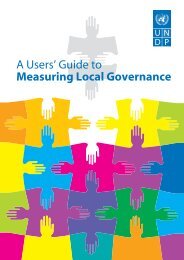English - UNDP
English - UNDP
English - UNDP
You also want an ePaper? Increase the reach of your titles
YUMPU automatically turns print PDFs into web optimized ePapers that Google loves.
Local Governance and Decentralization<br />
Since early 2009, the global economic and financial crisis has<br />
negatively affected Tajikistan’s fragile economy. Remittances from<br />
migrant workers fell by almost 15 percent 13 , affecting private<br />
consumption, reducing imports, and reducing construction<br />
activities. In addition, labour migrants returning to Tajikistan,<br />
mainly from Russia, are placing new demands on public services<br />
and pressurizing the country’s social fabric 14 . As a result, poverty<br />
rates are likely to increase in the short to medium term. Job<br />
creation and fiscal stimulus measures are challenging under<br />
current macroeconomic conditions.<br />
The fundamental challenge facing economic policy and future<br />
reforms in Tajikistan is to ensure an acceptable post-crisis<br />
growth for the economy, to alleviate poverty, and to increase<br />
employment.<br />
In 2005, the government, in partnership with <strong>UNDP</strong>, undertook<br />
a detailed assessment of resources needed to achieve the<br />
MDGs. A key conclusion highlighted a large resource gap and<br />
recommended donors to double aid to help the country to<br />
meet its MDG targets by 2015. The assessment formed a basis<br />
for alignment of national development strategies and policies<br />
with MDG priorities.<br />
Following this assessment, the Government of Tajikistan,<br />
with <strong>UNDP</strong>’s support, designed and adopted the National<br />
Development Strategy 15 2006-2015. This strategy focuses on<br />
three interlinked goals: (a) promotion of sustainable economic<br />
growth, (b) improvement of public administration, and (c)<br />
development of human resources.<br />
Two poverty reduction strategies (2004-2006 and 2007-<br />
2009) were also developed to help implement the National<br />
Development Strategy. The government subsequently<br />
adopted a third poverty reduction strategy (2010-2012), which<br />
included an action plan with much more realistic and focused<br />
targets. However, implementation of that action plan remains<br />
challenging, as there are no direct links between the strategic<br />
framework and financial resources from the national budget.<br />
Local governance system in Tajikistan<br />
Legal framework<br />
The administrative and territorial structure of the Republic of<br />
Tajikistan did not change after independence from the Soviet<br />
Union. It is still determined by the country’s administrativeterritorial<br />
structure 16 , defined in the Law on Local Government<br />
and the Order of Formation and Restructuring of the<br />
Administrative-Territorial Units.<br />
Tajikistan’s territory is divided by regions (oblasts) that, in turn,<br />
are sub-divided into districts, towns and villages. The Gorno-<br />
Badakhshan Autonomous Region is a special territorial and<br />
administrative unit with more autonomy than Sughd and<br />
Khatlon regions. Among the country’s administrative and<br />
territorial units, only the Gorno-Badakhshan Autonomous<br />
Region enjoys the right of legislative initiative. Formation and<br />
abolishment of regions is the responsibility of Parliament, when<br />
requested by the government.<br />
The administrative structure has another specific feature: 13<br />
districts do not have a regional authority, but are directly ruled<br />
by the centre, including three towns, 91 jamoats and three<br />
settlements. This is because these districts are located close to<br />
the centre. In most cases, towns are directly accountable to<br />
regions and the central government 17 .<br />
The local government structure is organized as follows:<br />
a The community level: village and town governments in<br />
rural areas (jamoat, shakhrak and dekhot).<br />
a The district level: administrations of cities and districts<br />
(rayons) subordinated to regions (oblasts), four Dushanbe<br />
city districts subordinate to Dushanbe city government<br />
as well as those of thirteen districts directly subordinate<br />
to the Republic.<br />
a The regional level: administrations of Dushanbe, the Gorno-Badakhshan<br />
Autonomous Region, and Khatlon and<br />
Leninabad regions, all of which are directly subordinate<br />
to the national government.<br />
Local authorities consist of representative and executive bodies<br />
that act within their terms of reference. Representative bodies<br />
in regions, cities and districts are assemblies (majils) whose<br />
delegates are elected for a period of five years. The khukumat is<br />
the assembly’s executive body. Both the representative and the<br />
executive bodies are headed by a chairman, who is appointed<br />
by the president and approved by an assembly 18 . In contrast,<br />
13<br />
The Country Partnership Strategy for Tajikistan 2010-2014 by the Asian Development<br />
Bank<br />
14<br />
According to the Asian Development Bank Country Partnership Strategy<br />
2010-2014, the number of labour migrants returning to Tajikistan is estimated<br />
at 460,000.<br />
15<br />
http://www.untj.org/principals/files/nds/nds_first_draft.pdf- National Development<br />
Strategy for the Republic of Tajikistan 2006-2015. Last access: 26<br />
April 2011.<br />
16<br />
Art. 76-80 and 83 of the Constitution of the Republic of Tajikistan.<br />
17<br />
These are so-called ‘direct rule towns’, which have a population of less than<br />
200,000, but are of significant administrative, industrial and social and cultural<br />
importance. However, the legislation does not clearly define the concept of<br />
‘republican importance’ and ‘direct republican rule’.<br />
12








![GuÃa del Usuario ] - Governance Assessment Portal](https://img.yumpu.com/44740603/1/190x253/gua-a-del-usuario-governance-assessment-portal.jpg?quality=85)








